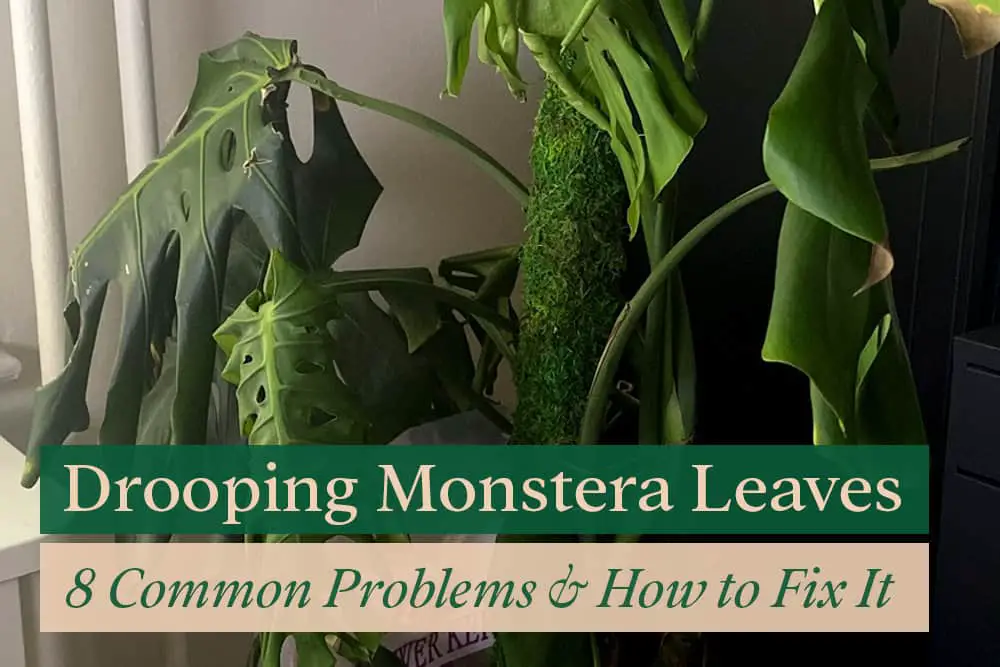
Are your Monsteras showing signs of distress? Many indoor plant owners have experienced drooping leaves at one point or another. While it may be alarming to see your plant’s leaves drooping, there is usually a simple explanation and solution.
The most common reasons for drooping Monstera leaves are either dehydration or overwatering. However, there are other potential causes, such as low humidity, incorrect lighting, temperature shock, overfertilizing, or pests.
Let’s take a closer look at each of these 8 potential causes and what you can do to fix the problem:
- Under-watering (Dehydration)
- Over-watering
- Incorrect lighting
- Temperature stress
- Low humidity
- Fertilization problem
- Transplant shock
- Pest infestation
Let’s get started!
Bloomsprouts may earn an affiliate commission if you purchase something through recommended links.
1. Underwatering
Do you remember the last time you watered your Monstera? If it has been more than two weeks, then it is likely that your plant is dehydrated. Dehydration is the most common cause of drooping Monstera leaves.

Signs
The easiest way to tell if your plant is dehydrated is to feel the soil. If the top two inches of the soil are dry to the touch, then it is time to water your Swiss Cheese plant.
Alternatively, a soil meter can be used to check the moisture level of the soil. A result on the dry end of the scale will indicate that the plant needs to be watered.
How to Fix
Luckily, dehydration is easy to fix. Simply water your plant until water runs out of the drainage holes at the bottom of the pot. Be sure to empty any water that has collected in the saucer to prevent root rot.
To prevent underwatering in the future, it is helpful to set a weekly watering schedule. This will help you to stay on top of your plant’s watering needs and avoid any potential problems.
Generally, Monsteras should be watered about once a week, or when the top two inches of soil are dry. However, this may vary depending on the size of the pot, type of soil, and temperature/humidity levels.
2. Overwatering
On the other hand, too much water can also cause your Monstera’s leaves to droop. Several factors can contribute to overwatering, such as watering too often, using a pot that is too big, or using the wrong type of soil.
The waterlogged soil of an overwatered plant prevents the roots from getting the oxygen they need to absorb water and nutrients properly. This causes the leaves to droop as a result of being suffocated.
If you don’t correct the problem quickly, soil fungus and bacteria can begin to grow, leading to root rot. Root rot is a serious condition that can kill your plant.
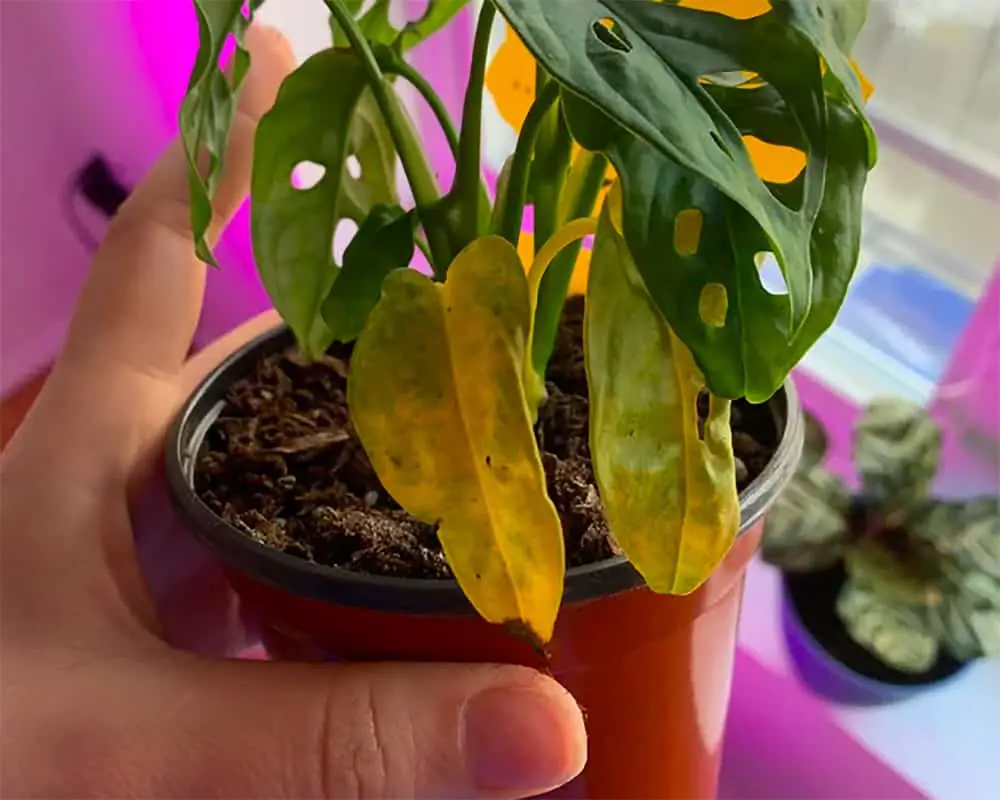
Signs
If the leaves of your Monstera are soft, limp, and turning yellow, it is a sign of overwatering.
Also, you may detect a rotting smell coming from the soil. This is a sign that the roots are beginning to rot and the plant is in danger.
A mushy stem base, brown splotches on the leaves, mold on the soil, and leaf edema are also signs of overwatering.
Confirm that your plant is overwatered by checking the moisture level of the soil with your finger or a soil meter. If the reading is on the wet end of the scale after more than two weeks, it is a sign that the soil is waterlogged.
How to Fix
First, make sure your soil has good drainage. If the soil is too dense, it will hold on to water and prevent the roots from getting the oxygen they need.
If your pot does not have drainage holes, it is important to repot your plant into a pot that does. Allowing the roots to dry out completely between waterings is essential to preventing root rot.
While larger pot sizes may seem like they would be better for your plant, they hold on to moisture for longer and can contribute to overwatering. You should use a pot that is only slightly larger than the root ball of the plant (at most 2 inches).
Next, cut back on watering and allow the soil to dry out completely before watering again. Be sure to empty any water that has collected in the saucer to prevent root rot.
If the leaves are already yellow and wilted, there is a chance that they will not recover. In this case, it is best to cut off the affected leaves and stems to allow the plant to focus its energy on new growth.
Also read: Can Monstera Recover from Root Rot?
3. Incorrect Lighting
In nature, Monstera plants grow in the dappled sunlight of the forest floor. They are used to filtered light and will not tolerate direct sunlight.
The ideal lighting situation for a Monstera is 8 hours of bright, indirect sunlight. An east or south-facing window is a good option, but make sure to filter the light with a sheer curtain or blinds to prevent scorching
Signs
Too much direct sunlight can cause the leaves of your Monstera to be scorched. The edges of the leaves will also curl, become crispy, and turn brown if the problem is not fixed quickly.
Conversely, too little light can cause the leaves of your Monstera to droop and languish as the plant stretches to find enough light.
How to Fix
When your Monstera leaves are already scorched, you can try to save the plant by moving it to a shadier spot and filtering the light with a sheer curtain or blinds.
To fix a plant that is not getting enough light, move it to a brighter location. However, be sure to do so slowly to avoid shocking the plant. Move the plant a few inches every day until it is in its ideal spot.
If you don’t have a location in your home that receives 8 hours of bright, indirect sunlight, you can supplement with artificial light. A grow light placed 12-18 inches from the plant will provide the light it needs to thrive.
4. Temperature Stress
Monstera plants are native to the tropical rainforests of Central and South America and thrive in warm, humid environments.
They do not tolerate extreme temperatures well and should be kept between 64 and 84°F (18 to 29°C). at all times.
A sudden temperature change, be it cold or hot, can cause the leaves of your Monstera to droop.
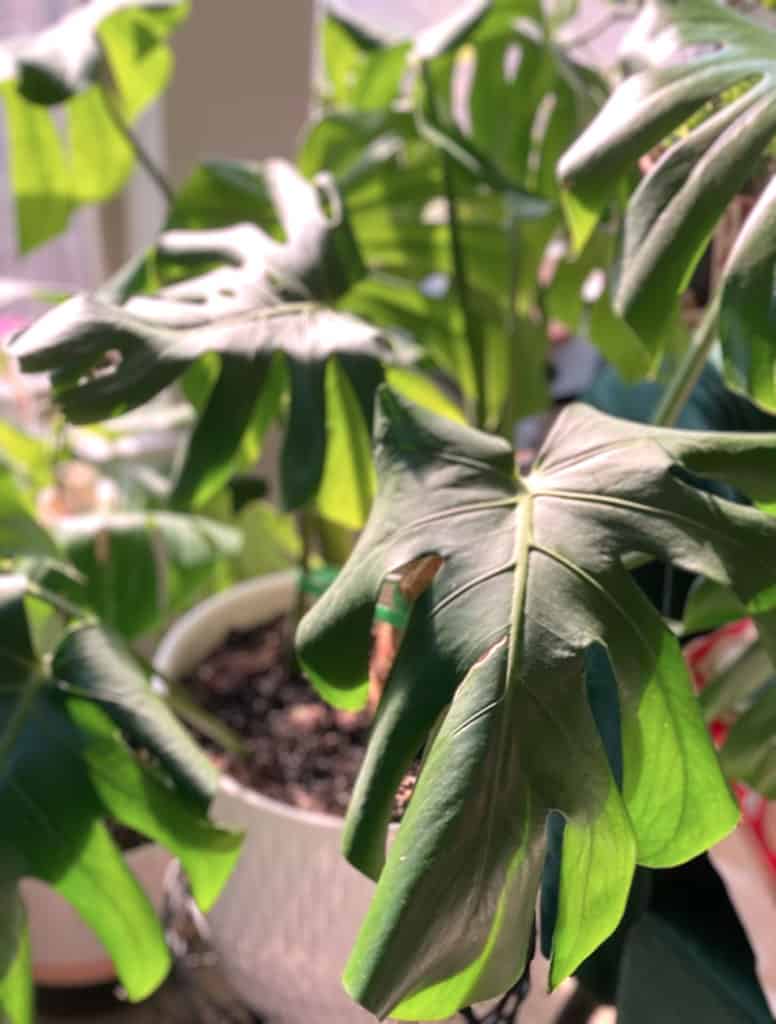
Signs
If the temperature drops too low, the leaves of your Monstera will turn yellow and then brown as the plant goes into shock. Additionally, there may be pale brown patches between veins or red/white marks along the veins. If the problem is not fixed quickly, the plant may die.
Conversely, if the temperature gets too high, the leaves of your Monstera will begin to curl, droop and develop leaf burn on its tips and margins.
How to Fix
First, check if the plant is near a heat source (such as radiators, fireplaces, furnaces, or other appliances that emit heat) or in direct sunlight. Move the plant to a cooler location immediately.
On the other hand, cold drafts from windows or doors can also cause temperature stress. Make sure to seal any cracks and keep your plant away from any sources of cold air.
Always have a room thermometer on hand to keep track of the temperature in your home.
If the temperature in your home is too cold, you can use a space heater to raise the temperature around the plant. Conversely, if the temperature is too hot, you can use a fan or air conditioner to cool things down.
But, turning the heater or air conditioner can cause the humidity in your home to drop. So, be sure to use a humidifier to maintain the ideal level of humidity for your Monstera (more on that later!).
5. Low Humidity
Moisture tends to move from areas of higher to the lower density moisture level.
This is why, when humidity around your Monstera gets low, the plant will start to draw moisture out of its leaves to make up for the lack of humidity in the air. This process is called transpiration.
If the humidity is too low for too long, and the roots can’t keep up with the water demand, the leaves will start to droop as the plant becomes dehydrated.
This is especially common in the winter when the air is drier as heaters are running for hours a day.
Signs
The most common signs that your Monstera is not getting enough humidity are upward curling, crispy leaves, wilting, and yellowing. You might also see the tips of the leaves turning brown or black.
Growth will also slow down as the plant becomes stressed. If the problem is not fixed quickly, your Monstera may expect premature defoliation and death.
How to Fix
The easiest way to increase the humidity around your Monstera is to use a humidifier. Just be sure to place it close enough to the plant so that it gets the benefit of the extra moisture in the air.
You can also create a makeshift humidifier by placing your plant on top of a pebble tray. To do this, just fill a tray with pebbles and water. The water will evaporate, increasing the humidity around your plant.
Another way to increase the humidity is to group your plants together. As the plants transpire, they will raise the humidity for each other.
6. Fertilizer Problems
Fertilizing your Monstera is important to help it grow and thrive. But, over-fertilizing can lead to a whole host of problems, including drooping leaves.
When you over-fertilize your plant, the roots are unable to take up all the nutrients in the water. These fertilizers then start to build up in the soil and can burn the roots of your plant.
This root damage prevents the plant from taking up water properly, causing dehydration and the leaves to droop.
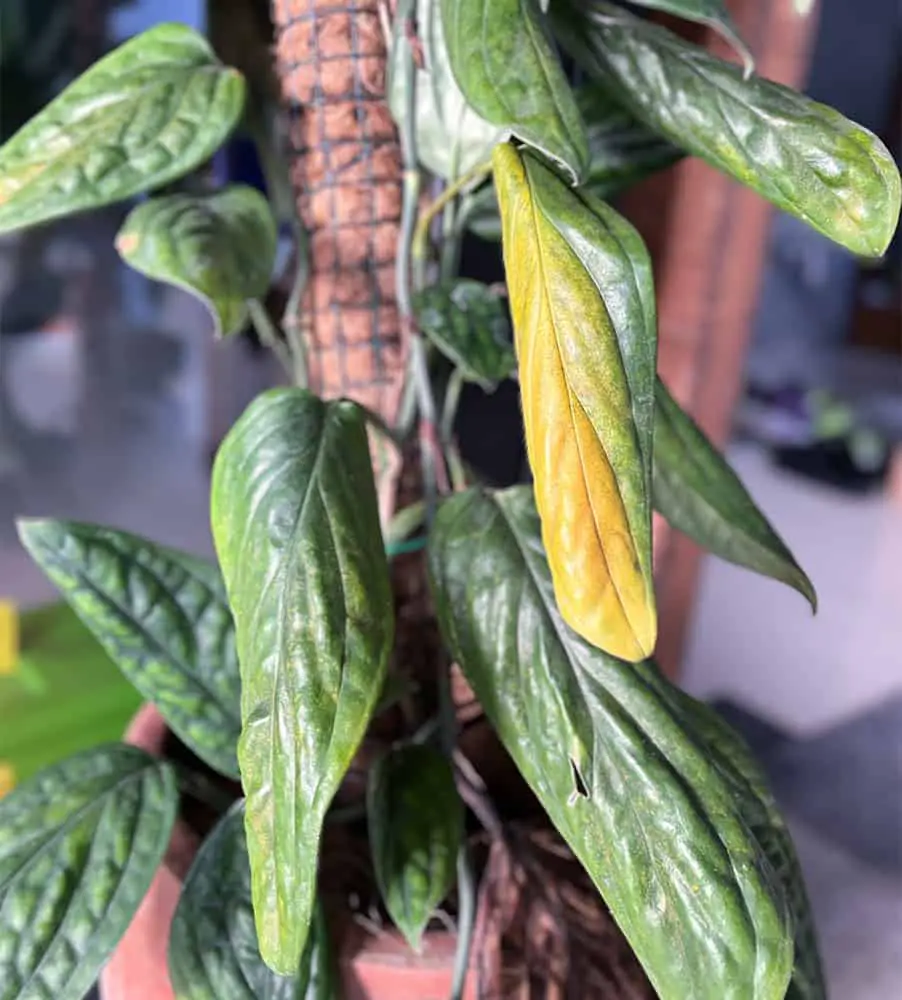
Signs
Check the soil for white, powdery residue. This is a sure sign that you have over-fertilized your plant.
You might also see the lower leaves turning yellow and brown and eventually dropping off. The tips and leaf margins might also start to turn brown.
How to Fix
Start with scooping out any excess fertilizer (white crust) from the top of the soil.
Then flush the potting mix with clean water to help remove any fertilizer buildup. To do this, just place your plant in the sink or tub and let the water run through the soil for a few minutes. Then let the excess water drain out completely.
Repeat the leaching process to make sure all the fertilizer has been removed from the soil.
Once you have flushed the potting mix, don’t fertilize your Monstera again for at least a month.
Alternatively, you might want to repot your plant into a fresh potting mix.
7. Transplant Stress
Did you just repot your Monstera? If so, it’s not uncommon for the leaves to droop a bit as the plant adjusts to its new environment.
Especially if you disturbed the roots during the transplant, your plant will need some time to recover. It’s not unusual for the leaves to droop for a week or two after repotting.
If the leaves are still wilting and drooping after a couple of weeks, it’s probably due to one of the other problems on this list.
How to Prevent
Try to handle your plant’s roots as little as possible when repotting. Gently loosen the potting mix around the roots and slide the plant out of the pot.
Do not prune the roots unless they are infected with root rot or fungi. Pruning the roots will only damage them further and make it longer for your plant to recover.
When replanting, use a pot that is only slightly larger than the current one. A pot that is too large will hold too much water and can lead to overwatering (see problem #2).
Also, you can provide Hormex Vitamin B1 Rooting Hormone Concentrate to the plant before replanting. It will prevent shock and help the roots recover quickly.
8. Pests Infestation
Last but not least, pests can also cause your Monstera’s leaves to droop. Thrips, mealybugs, and spider mites are all common plant pests that can damage your plant.
These sap-sucking pests steal moisture and nutrients from your plant and injure the leaves. As a result, the leaves start to droop and languish.
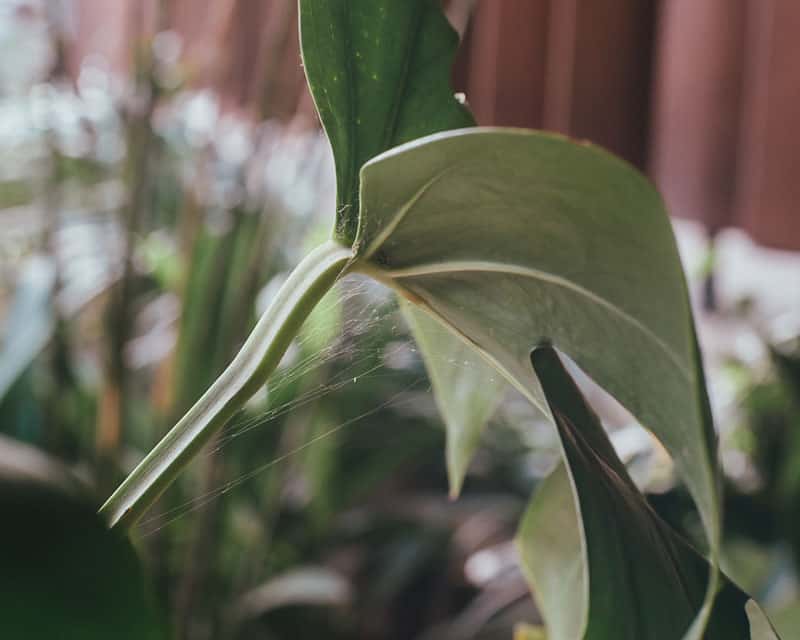
Signs
Check both sides of the leaves for small, dark-colored bugs. You might also see white, cottony masses on the leaves and stems. These are mealybugs.
If you see small webbing on the plant, that’s a sign of spider mites.
Changes in leaf color or texture can also indicate pests. They may cause spotted, speckled, or yellowed leaves.
How to Fix
The best way to get rid of pests is to take your plant outdoors and wash it with water. This will remove most of the bugs and larvae from your plant.
Make sure to tip the pot on its side and rinse all the bugs out of the potting mix as well.
If you can’t take your plant outdoors, you can also use a mixture of water and dish soap to remove the pests.
To make this solution, mix 1 teaspoon (5 ml) of mild dish soap with 1 quart (946 ml) of water. Use a soft cloth to wipe the leaves and stems with this solution.
You can also use insecticidal soap or neem oil to kill any remaining pests. Repeat the process every few days until all the pests are gone.
Other less common Monstera leaves drooping causes
While the eight problems above are the most common reasons why Monstera leaves droop, there are a few other possibilities to consider.
Dusty leaves
Dust can accumulate on the leaves of Monstera, especially if they’re in a high-traffic area.
If the leaves are dusty, transpiration will be reduced and the plant will have a harder time taking up water. As a result, the leaves may start to droop.
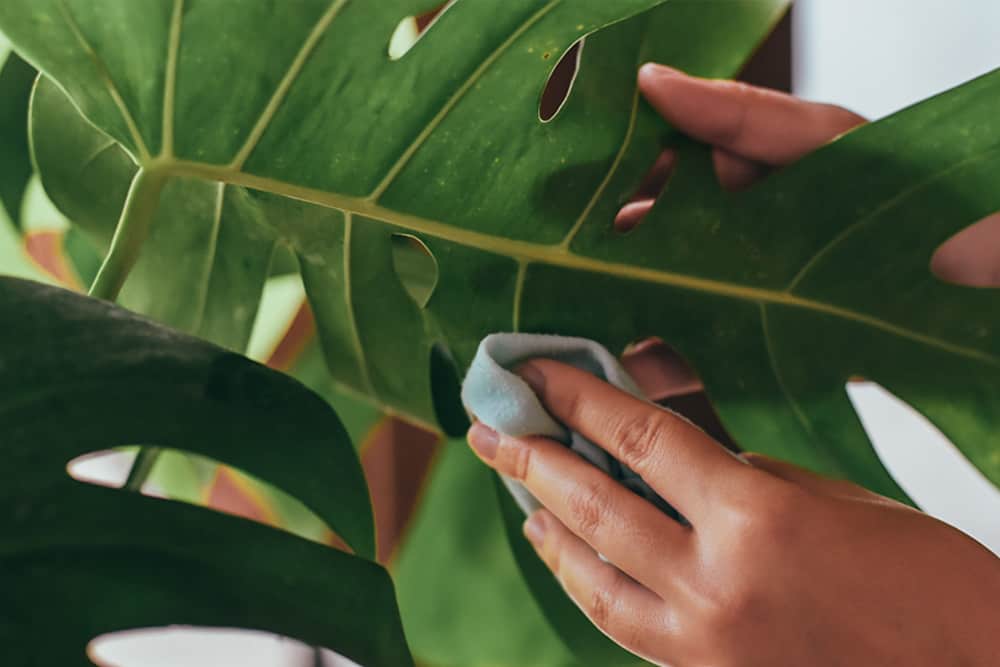
To prevent this problem, wipe the leaves down with a damp cloth every week or so. This will remove the dust and allow the plant to “breathe” more easily.
By cleaning your Monstera’s leaves, you can also detect pests and powdery mildew early on.
Droopy Monstera Cutting After Propagation
If you’ve just propagated your Monstera, it’s not unusual for the leaves to droop.
This is especially common if you let the cutting dry out before planting it. Once planted, the cutting will need time to develop a strong root system. Until then, the leaves may remain wilted and droopy.
Just give your new cutting a week or two and it should start to perk up.
Drooping Stems From Lack of Support
Monstera is a climbing plant and will need some form of support to grow properly. Without support, the stems will start to droop under the weight of the leaves.
To fix this problem, simply provide a moss pole, trellis, or another type of support for the plant. You can also try tying the stems to the support with plant ties.
Once the stems are secure, they should start to grow upright again.
Rootbound
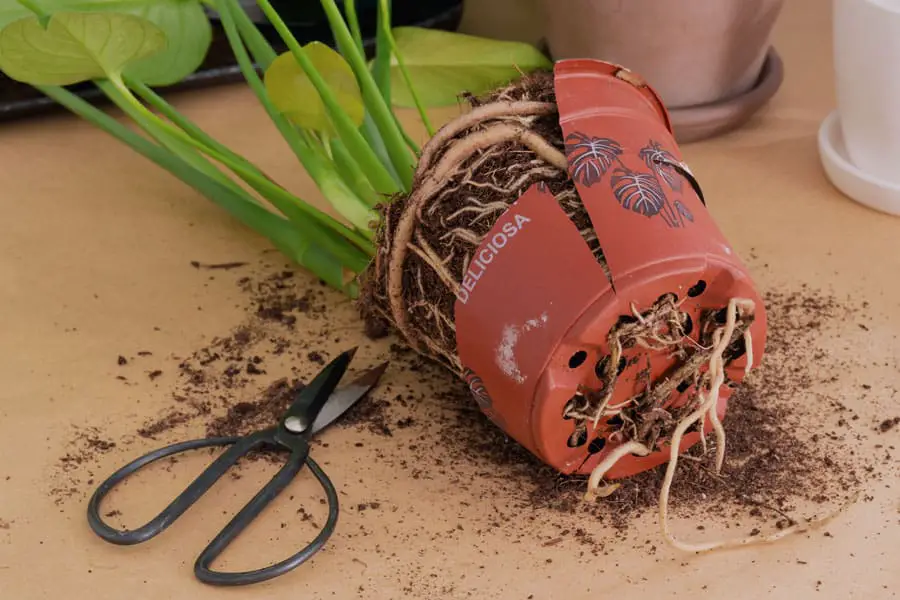
In a potbound Monstera, the roots will be constricted and unable to take in water. This will result in the plant becoming dehydrated and the leaves drooping.
To fix this problem, you’ll need to repot the plant in a larger pot. Make sure to use a well-draining potting mix and water the plant thoroughly after repotting.
It’s also a good idea to add a support system when repotting. This will help the plant grow upright and prevent the leaves from drooping.
Frequently Asked Questions
Can Drooping Monstera be Fixed?
Drooping leaves in Monstera are generally an early warning sign. Early intervention can prevent permanent damage to the leaves and allow them to make a full recovery
Should I remove drooping leaves?
There is no need to remove drooping leaves, as they will usually recover on their own. If the leaves are significantly wilted or discolored, you can trim them back to encourage new growth.
How long will it take my monstera to recover?
Watering usually fixes light dehydration within a few hours. In severe cases, such as overwatering or overfertilizing, significant improvement can take several weeks (or even a month).
